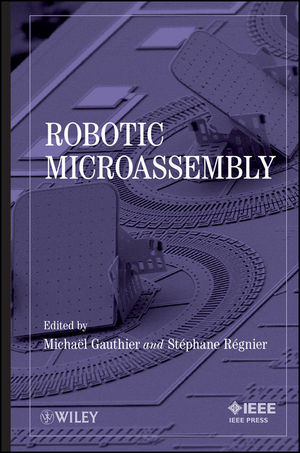Robotic MicroassemblyISBN: 978-0-470-48417-3
Hardcover
328 pages
October 2010, Wiley-IEEE Press
 This is a Print-on-Demand title. It will be printed specifically to fill your order. Please allow an additional 10-15 days delivery time. The book is not returnable.
|
||||||
Introduction.
PART I MODELING OF THE MICROWORLD.
1 Microworld modeling in Vacuum and Gaseous Environments.
1.1 Introduction.
1.2 Classical models.
1.3 Recent developments.
References.
2 Microworld Modelling: Impact of liquid and roughness.
2.1 Introduction.
2.2 Liquid environments.
2.3 Microscopic analysis.
2.4 Surface Roughness.
References.
PART II HANDLING STRATEGIES.
3 Unified view of robotic microhandling and selfassembly.
3.1 Background.
3.2 Robotic Microhandling.
3.3 SelfAssembly.
3.4 Components of Microhandling.
3.5 Hybrid Microhandling.
3.6 Conclusion.
References.
4 Towards a precise micro manipulation.
4.1 Introduction.
4.2 Handling principles and strategies adapted to the microworld.
4.3 Micromanipulation setup.
4.4 Experimentations.
4.5 Conclusion.
References.
5 Microhandling Strategies and Microassembly in Submerged.
Medium.
5.1 Introduction.
5.2 Dielectrophoretic Gripper.
5.3 Submerged freeze gripper.
5.4 Chemical control of the release in submerged handling.
5.5 Release on adhesive substrate and microassembly.
5.6 Conclusion.
References.
PART III ROBOTIC AND MICROASSEMBLY.
6 Robotic microassembly of 3D MEMS Structures.
6.1 Introduction.
6.2 Methodology of the Microassembly System.
6.3 Robotic Micromanipulator.
6.4 Overview of Microassembly System.
6.5 Modular Design Features for Compatibility with the Microassembly System.
6.6 Grasping Interface (Interface Feature).
6.7 PMKIL Microassembly Process.
6.8 Experimental Results and discussion.
6.9 Conclusion.
References.
7 High Yield Automated MEMS Assembly.
7.1 Introduction.
7.2 General Guidelines for 2 1 2D Microassembly.
7.3 Compliant Part Design.
7.4 3 Microassembly System.
7.5 High Yield Microassembly.
7.6 Conclusion and Future work.
References.
8 Design of a desktop microassembly machine and its industrial.
application to micro solder ball manipulation.
8.1 Introduction.
8.2 Outline of the machine design to achieve fine accuracy.
8.3 Application to the joining process of electric Components.
8.4 Pursuing higher accuracy.
8.5 Conclusion.
References.



